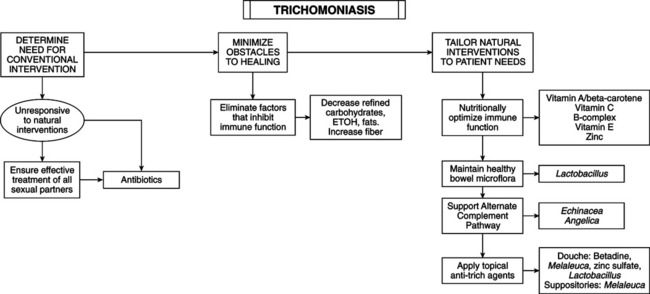• Profuse, malodorous, white to green discharge from vagina. • Discharge usually has a pH greater than 4.5, a weak amine odor, and large numbers of white blood cells and trichomonads on wet mount. • Vulvovaginal pruritus, burning, and/or irritation. • Vulva and introitus usually show erythema. • Cervix may or may not have a mottled erythema “strawberry cervix” (less than 5%). • Dysuria and/or dyspareunia may be present. • Rule out trichomoniasis in men exhibiting signs of prostatitis, urethritis, or epididymitis. • Gonorrhea (GC) and trich commonly coexist; 40% of women with trich have GC and vice versa. • Trich frequently causes cervical erosion (90%), a factor in malignancy. • Trich may complicate interpretation of Pap smears, increasing number of false-positive results. • Trich increases sterility in women (salpingitis) and men (toxins decrease motility of spermatozoa). • Increased postpartum fever and discharge in women with Trichomonas vaginalis at delivery. • Neonates infected from passage through the birth canal may manifest serious illness (rare). • Prostatitis and epididymitis are common in infected men. • Infection may confuse and/or complicate other genitourinary tract problems. • Metronidazole (Flagyl) (most common anti-trich agent) is carcinogenic and teratogenic in rodents. • Trich increases HIV transmission and infectivity where HIV seropositive men with concomitant trichomoniasis may have sixfold higher concentration of HIV RNA in seminal plasma. • Sexual transmission is the route of infection. Prevalence is highest among women with multiple partners and women with other sexually transmitted infections. Transmission rates are high from men to women; an 80%-100% prevalence exists in female partners of infected men. • In women, T. vaginalis infests the vagina and urethra and may involve the endocervix, Bartholin’s glands, Skene’s glands, and bladder. — Vagina is a good reservoir; estrogen causes walls to be glycogenated. Prepubescent and postmenopausal women seldom have trich symptoms. — Elevated pH increases susceptibility. Normal adult vaginal pH is 3.5-4.5 because of Lactobacillus acidophilus converting free glucose into lactic acid. Decreased lactobacilli increase pH. Trichomonas grow optimally at a pH of 5.5-5.8. Other conditions increasing vaginal pH are progesterone (latter half of menstrual cycle and during pregnancy), excess intravaginal secretions (cervical mucus), and bacterial overgrowth (Streptococcus, Proteus).
Trichomoniasis
DIAGNOSTIC SUMMARY
GENERAL CONSIDERATIONS

DIAGNOSIS
Trichomonal Vaginitis
![]()
Stay updated, free articles. Join our Telegram channel

Full access? Get Clinical Tree


Trichomoniasis
